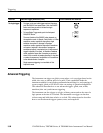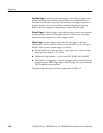
Triggering
CSA7000 Series, TDS7000 Series, & TDS6000 Series Instruments User Manual
3-89
You can check the advanced trigger status in the readout. The readout indicates
the trigger type and then shows sources, levels, or any other parameters that are
important for the particular trigger type. Figure 3--25 shows an example readout
for the state trigger type.
Trigger type = State
Ch 1, 2, 3 Inputs = High,
Don’t Care, Don’t Care
Ch 4 Input = Rising Edge
Logic = AND
Figure 3- 25: Example advanced t rigger readout
Read the following topics; they provide details that can help prevent false steps
in setting up to trigger on your waveforms.
Glitch Trigger. A glitch trigger occurs when the trigger source detects a pulse
narrower (or wider) than some specified time. It can trigger on glitches of either
polarity. Or you can set the glitch trigger to reject glitches of either polarity.
Runt Trigger. A runt trigger occurs when the trigger source detects a short pulse
that crosses one threshold but fails to cross a second threshold before recrossing
the first. You can set the instrument to detect any positive or negative runt pulse,
or only those wider than a specified minimum width.
Width Trigger. A width trigger occurs when the trigger source detects a pulse that
is inside or, optionally, outside some specified time range (defined by the upper
limit and lower limit). The instrument can trigger on positive or negative width
pulses.


















